Last time, I talked about cold fusion, which was strangled at birth by Big Science vested interest. Martin Fleischmann and Stanley Pons gave their press conference on March 23rd 1989 in Salt Lake City. Just over a month later on May 1st 1989, eighteen hundred physicists in Baltimore gave a standing ovation to accusations of incompetence and delusion. A whole host of organisations piled on the opprobrium, including the Brookhaven National Laboratory, Caltech, CERN, the Lawrence Berkeley Laboratory, MIT, Nature, the University of Rochester, Science, and Yale.
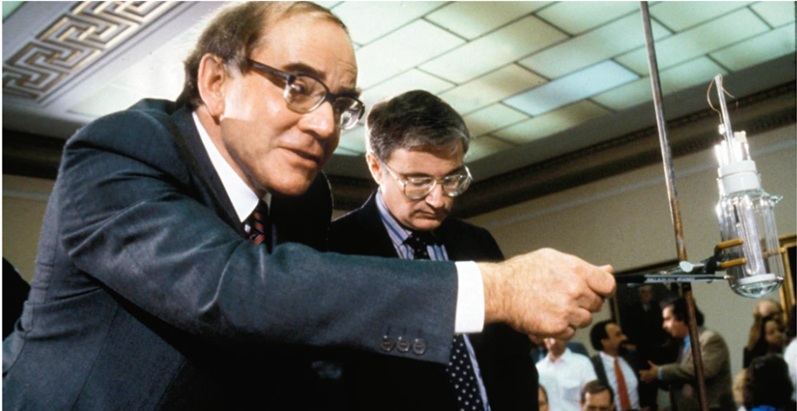 Fleischmann and Pons image from Time magazine May 8th 1989. Also see the cover story and CBS news
Fleischmann and Pons image from Time magazine May 8th 1989. Also see the cover story and CBS news
See for example the March 1990 Nature article The embarrassment of cold fusion by David Lindlay. He also wrote a companion piece called Farewell (not fond) to cold fusion. They’re awful. He sneered at letters “handwritten entirely in capital letters”. He scoffed at the production of “⁴He and a gamma ray rather than tritium and a proton or ³He and a neutron, as conventional nuclear physics would have it”. He dissed effective mass because he didn’t know about muon catalyzed fusion, and he used words like absurd, magic, nonsense, the philosopher’s stone, and unicorns. Dreadful, but that’s Nature for you: if you don’t adhere to the narrative you are persona non grata. Also take a look at the Science articles on cold fusion. See for example the 1994 review of Gary Taubes’ book Bad Science. The Short Life and Weird Times of Cold Fusion: “Taubes reliably covers this period during which the scientific community came to its senses: enthusiasm turns to anger. and the charges range from ineptitude to fraud”. The denigration was so bad that most journals refused to publish cold fusion papers, and cold fusion became a dirty word. So much so, that the field renamed itself LENR, standing for Low Energy Nuclear Reactions. See the LENR forum for some great information on the subject. Sadly if you search Wikipedia for LENR, you find yourself on the cold fusion page being told that cold fusion was a pariah field that had been cast out by the scientific establishment.
In these circumstances, crackpots flourish
That’s from David Goodstein’s 1994 Engineering and Science article Whatever happened to cold fusion? He also said this: “Between cold fusion and respectable science there is virtually no communication at all. Cold fusion papers are almost never published in refereed scientific journals”. On top of that he said “In these circumstances, crackpots flourish”. Oh the irony¹. If that wasn’t enough, he said his Caltech colleagues Steven Koonin, Nathan Lewis, and Charles Barnes executed “a perfect slam-dunk that cast cold fusion right out of the arena of mainstream science”.
 Steve Koonin APS 1989 image and caption from David Goodstein’s Whatever happened to cold fusion?
Steve Koonin APS 1989 image and caption from David Goodstein’s Whatever happened to cold fusion?
However the article is not wholly hostile to cold fusion. Goodstein told how when two deuterium nuclei fuse, they momentarily form a helium-4 nucleus, but there’s so much excess energy that the helium-4 breaks up, emitting a neutron nearly half the time, and a proton nearly half the time. However there’s a small chance that the helium-4 doesn’t break up, and emits a gamma photon. He also said one of his buddies at Caltech said Pons and Fleischmann’s cold fusion was bullshit, because their excess heat would have come with a neutron flux that would have killed them. But he cast doubt on that by referring to the Mossbauer effect, and suggested that the missing ingredient might be a deuterium loading of 0.85. In addition he talked about careful work by Franco Scaramuzzi et al at the University of Rome, which indicated that fusion was indeed occurring. This article is worth reading. Even if Goodstein said he didn’t believe in cold fusion.
Cold welding uses pressure alone
I don’t share his sentiment. That’s because I have current-best-fit opinions rather than beliefs, because my speciality is fundamental physics, and because of a little something called welding. An arc welder uses a high-temperature “blue” heat and no pressure to fuse two pieces of metal together. A blacksmith uses a medium-temperature “yellow” heat and the pressure of his hammering to fuse two pieces of metal together. It’s called forge welding. Meanwhile cold welding uses pressure alone:
 Arc welding image from the USAF, forge welding image from iforgeiron.com, cold welding image from the engineer
Arc welding image from the USAF, forge welding image from iforgeiron.com, cold welding image from the engineer
Cold welding has been around for a long long time. Check out Cold Welding Explained by Jeff Grill. He tells us that cold welding started in the Bronze Age, that the first documented cold welding experiment was performed in 1724 on lead balls by J T Desaguliers², and that light-alloy aircraft elements were cold-welded in 1940s Germany.
There’s no such thing as a hot neutron
For successful cold welding, it helps if the contact surfaces are clean, flat, and polished, with no oxide layer. In addition Desagulier talked about giving them a twist. You can see something similar in this video, and you may recall doing something similar with snowballs. These cold welded balls are important, because there’s another method to weld lead balls together, without an arc welder or a forge. You make them fly towards one another such that they collide head-on at high speed. You have doubtless seen the pictures of the civil war bullets:
 Siege of Vicksburg welded bullets image from civilwartalk.com, original from The Gilder Lehrman Institute
Siege of Vicksburg welded bullets image from civilwartalk.com, original from The Gilder Lehrman Institute
The moot point is that you can make two lumps of lead fuse together if you apply lots of pressure, whether that’s via a high speed head-on collision, or slow brute force. The important thing to note is that the high speed head-on collision is just another way of exerting pressure. Another thing to note is that the principle applies to subatomic particles as well as lumps of lead. A subatomic particle has no property of heat or temperature. It’s as per the kinetic theory of gases. A hot gas is merely a gas where the gas molecules are moving fast. You’re sitting in a room full of hot gas right now, called air, at circa 300°K. Air is mainly made up of nitrogen and oxygen molecules, and at 300°K they’re moving at about 500 m/s. The oxygen molecules are a little heavier and usually a little slower, but you get the drift. The temperature of the gas is an emergent property, which is why there’s no such thing as a hot nitrogen molecule. In similar vein there’s no such thing as a hot neutron. There are fast neutrons, but not hot neutrons. Whilst physicists do talk of neutron temperature, this is a figure of speech because it’s a measure of a neutron’s kinetic energy, and therefore its speed. A “cold” neutron is just a slow neutron³.
If you can make a neutron via electron capture, you can then make a deuteron, and there’s no Coulomb barrier
The same rules apply for the deuteron, which a deuterium nucleus, the triton, which is a tritium nucleus, a helion, which is a helium-3 nucleus, and an alpha particle, which is a helium-4 nucleus. The deuteron consists of a proton plus a neutron, a triton consists of a proton and two neutrons, a helion consists of two protons and one neutron, and an alpha particle consists of two protons and two neutrons:
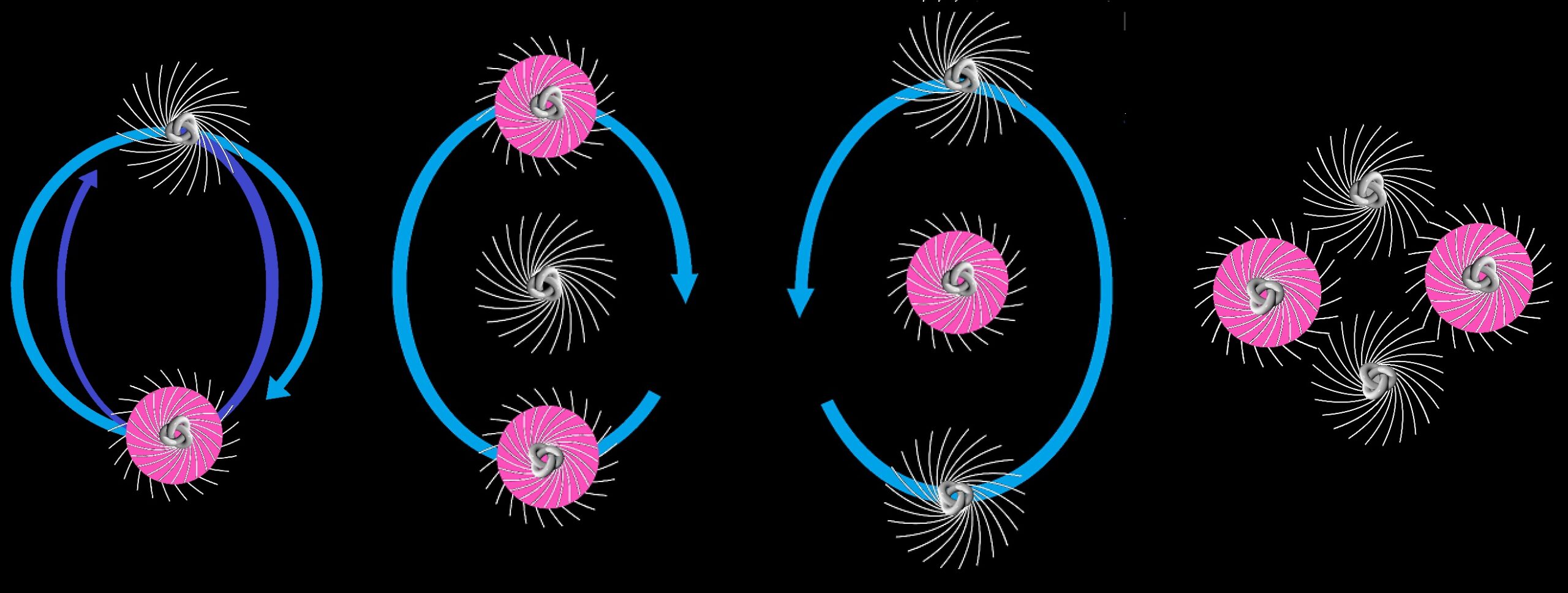 Deuteron, triton, helion, and alpha particle, nuclei of deuterium, tritium, helium-3, and helium-4
Deuteron, triton, helion, and alpha particle, nuclei of deuterium, tritium, helium-3, and helium-4
The deuteron has a binding energy of 2.224 MeV, the triton has a binding energy of 8.481 MeV, the helion has a binding energy of 7.718 MeV, and the alpha particle has a binding energy of 28.295 MeV. That’s more than 12 times the bindng energy of the deuteron, but like I was saying last time, if you can make a neutron via electron capture, you can then make a deuteron, and there’s no Coulomb barrier. What’s not to like?
A neutron flux can kill, and it can destroy materials
There’s a lot not to like about hot fusion. The hot fusion folk favour deuterium–tritium fusion because they say it produces the highest energy gain at the lowest temperatures. However the issue is that the 17.6 MeV yield blasts out the surplus neutron at about a sixth the speed of light. This neutron is conveying about 80% of the fusion energy, and is an awkward customer. A neutron flux can kill, and it can destroy materials. Hence Helion energy prefer deuterium-helium-3 fusion, which is aneutronic. It yields 18.3 MeV and emits a fast proton which can be controlled via electromagnetism. Aneutronic fusion is good, but what’s even better is the rarer form of deuterium-deuterium fusion which yields helium-4 plus a gamma photon:
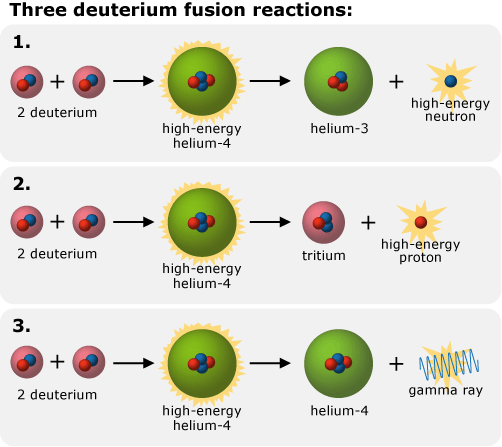 Image from Cold fusion: Teammate or rival? from Berkeley’s Understanding Science
Image from Cold fusion: Teammate or rival? from Berkeley’s Understanding Science
As to how you perform deuterium-deuterium fusion to yield helium-4 and gamma photons, I don’t know, but the LENR forum guys⁴ told me that many in the field think this is the predominant reaction pathway in LENR. They referred to the 2002 paper by De Ninno et al, and the 2024 papers by Metzler et al and Czerski et al. Whatever the ins and outs of it, I know it isn’t something magical. How do you grip your particles and push them together with enough slow brute force to make them fuse and release a pure-kinetic-energy photon? Or kinetic energy in some other form⁵ which shows up as heat? Maybe Lynn Bowen has the answer, see her IWAHLM-16 Strasbourg presentation and her ICCF25 presentation. I don’t know if she has, because condensed matter is above my pay grade. But I know it isn’t something magical. It’s just an engineering problem. Hence I know it was wrong to vilify cold fusion in entirety just because the Fleischmann and Pons setup didn’t seem to work. After just over a month. That was throwing the baby out with the bathwater.
That immediately raised a red flag called tabletop fusors
Anyway, the 1999 Physics World article Whatever happened to cold fusion? is worth reading too. It’s by David Voss. He talked of bitter accusations that hot-fusion physicists and particle physicists were out to get the cold-fusion community. He also said cold fusion was not quite dead and buried because a dedicated circle of enthusiasts kept the flame alive. He likened cold fusion to “pathological science”, whose defenders had soldiered on, some merging with conspiracy theorists, psychic spoon-benders, and UFO enthusiasts. Sigh. Voss also said the experimental situation was murky, in spite of claims by cold-fusion proponents that experiments had provided evidence of tabletop nuclear reactions. That immediately raised a red flag called tabletop fusors. Check out the Wikipedia fusor article: “the machine induces a potential difference between two metal cages, inside a vacuum. Positive ions fall down this voltage drop, building up speed. If they collide in the center, they can fuse”. It also says “a growing number of amateurs have performed nuclear fusion using simple fusor machines”. Quite. These star in a jar devices perform tabletop nuclear reactions.
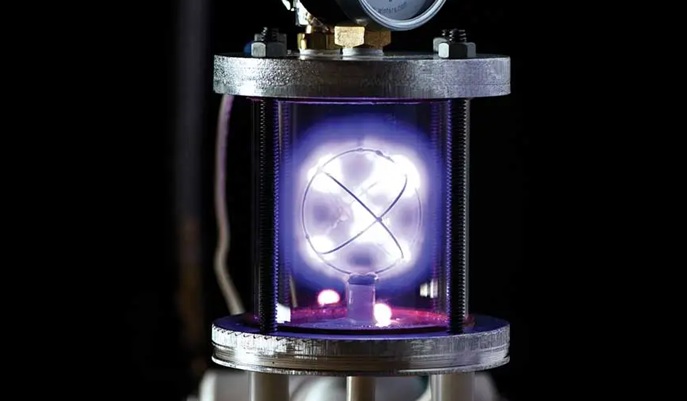 Star in a jar fusor by Dan Spangler, see makezine.com
Star in a jar fusor by Dan Spangler, see makezine.com
Whilst they don’t yield net energy, they really do do fusion. The Wikipedia fusor article also tells us that about 3 to 10 keV is needed to allow the reaction to take place, and that a typical television cathode-ray tube is in the order of 3 to 6 keV. So you can do fusion with something that has the same power as the boxy old TV set up in your attic. Check out fusor.net, which gives a wealth of great information, including Fusor Construction & Operation, Interesting Links, Past, Present, and Future, News, and Primary Sources for Fusor Related Items. Sadly you can also read about Doug Coulter being no longer with us. I talked to Doug many times many years ago, on Coulter’s Smithing Forums. I laughed out loud when Doug told me about the cold fusion sceptics at the US Department of Energy. He said if you told ‘em your pipe was red hot and you just couldn’t cool it down, the men in black would be arriving first thing on the redeye to “help”. LOL! We miss you Doug. Salt of the Earth.
The nuclear force is electromagnetic
That was when things were starting to improve. Take a look at the 2009 BBC article Cold fusion debate heats up again. It referred to the Amercian Chemistry Society, and was the shape of things to come. Yes, the BBC included disparaging comments from Frank Close, but no matter, because a year later Edmund Storms wrote Status of cold fusion (2010). It’s on Researchgate, and is much more positive. I thought it was a joy to read myself. It’s 30 pages long with 158 references, and it conveys so much. In 2013 came reports of Andrea Rossi’s eCat which generated excitement. I know there are issues with Rossi, but I was interested to read this: “the nickel’s electrons are forced into the hydrogen to produce neutrons; the nickel nuclei absorb these neutrons; the neutrons are stripped of their electrons to become protons; and thus the nickel goes up in atomic number from 28 to 29, becoming copper”. That sounds like a 2013 NASA piece which similarly featured transmutation of nickel into copper. I liked that, because it’s from NASA, and because as far as I can tell electron capture does what it says on the tin. Indeed, as far as I can tell, the neutron is a close-coupled proton-electron combination, like Ernie Rutherford said, albeit with a neutrino twist. The nuclear force plot matches the neutron charge distribution. Which means the nuclear force is electro-magnetic too, like Bernard Schaeffer said.
 Nuclear force plot from the Dux college HSC physics course, neutron charge distribution image by Dru Renner
Nuclear force plot from the Dux college HSC physics course, neutron charge distribution image by Dru Renner
After all, there are no nuclei that consist of a multiple protons or multiple neutrons. After all, the pion-exchange theory of nuclear force⁶ has been an absolute disaster. No wonder, because as Cathryn Carson said in the peculiar notion of exchange forces, the exchange-particle idea worked its way into QED from the mid-1930s, even though Heisenberg used a neutron model that was later retracted. And guess what? Hydrogen atoms don’t twinkle, and magnets don’t shine. Because there are no exchange particles. The irony is that the people who denigrate LENR are the people who peddle the Standard Model of particle physics, which is so badly wrong it’s cargo cult crap. Those guys don’t even know that light interacts with light in gamma-gamma pair production, like Kirk McDonald said. They don’t know that the electron is a self-confined photon, like Williamson and van der Mark said. Maxwell would have called it a worble embracing itself. Tait would have called it a trivial knot. It’s a wave in a closed path⁷, like Schrödinger said, such that a sinusoidal field variation looks like an all-round standing field. Which means charge is topological. Which means color charge is moonshine. It also means electron spin is a real rotation, like Einstein and de Haas said. Which is why electromagnetism has a screw nature, like Maxwell and Minkowski said. Which is why charged particles attract and repel like counter and co-rotating vortices. And if there are no exchange particles, there are no W-bosons, so their discovery is suspect. So is electroweak theory, because beta decay is just the flip side of electron capture, which does what it says on the tin. For the cherry on top, all this means the mass of a body is a measure its energy-content, like Einstein said. Because mass is just resistance to acceleration for a wave in a closed path. So where does that leave the “discovery” of the fabulous Higgs boson? Nowhere, because Big Science particle physics is as futile as cataloguing firework explosions to try to discover the secrets of gunpwder⁸.
By 2015 the LENR field was beginning to heat up
But I digress. Apologies, because by 2015 the LENR field was beginning to heat up. That’s when Popular Mechanics ran an article called Can Cold Fusion Come Back From the Dead? It referred to an Aeon essay by Huw Price. It’s a great read. I just loved this: “as several people have noticed, a new clean source of energy would be really, really useful right about now”. I also loved the way he mentioned Galileo and the Inquisition. You don’t know the half of it Huw. Moving swiftly on, in 2016 CBC ran a piece called Why the controversial science of cold fusion is getting hot again. In 2017 the BBC ran a piece called fusion energy pushed back beyond 2050. In 2018 the IEEE ran an article called Scientists in the U.S. and Japan Get Serious About Low-Energy Nuclear Reactions. Things were gathering pace.
That’s what stayed in my craw for all these years
In 2019 National Geographic ran an article called Cold fusion remains elusive—but these scientists may revive the quest. It’s about Google investigating cold fusion. I like this from Matt Trevithick: “the story [of cold fusion] was decided in a matter of months, and nothing in science is decided that quickly. That’s what stayed in my craw for all these years”. Well said Matt. Sadly Google drew a blank, but their interest is symptomatic of an ongoing flowering of LENR. Fast forward to 2023 for the Popular Science article Cold fusion is making a scientific comeback by Rahul Rao. Check out the 2023 Discover Magazine article What is Cold Fusion? which talks about catching a second wind. See infinite energy dot com, where I particularly liked Exposing the “Real Embarrassments” of Cold Fusion by Scott Chubb. See LENR News which talks about the CleanHME event at the University of Szczecin in January 2025. That’s where high-energy particle emissions and excess heat were reported by multiple laboratories. CleanHME was one of the projects sponsored by the €80 billion Horizon 2020 progamme funded by the European Commission:
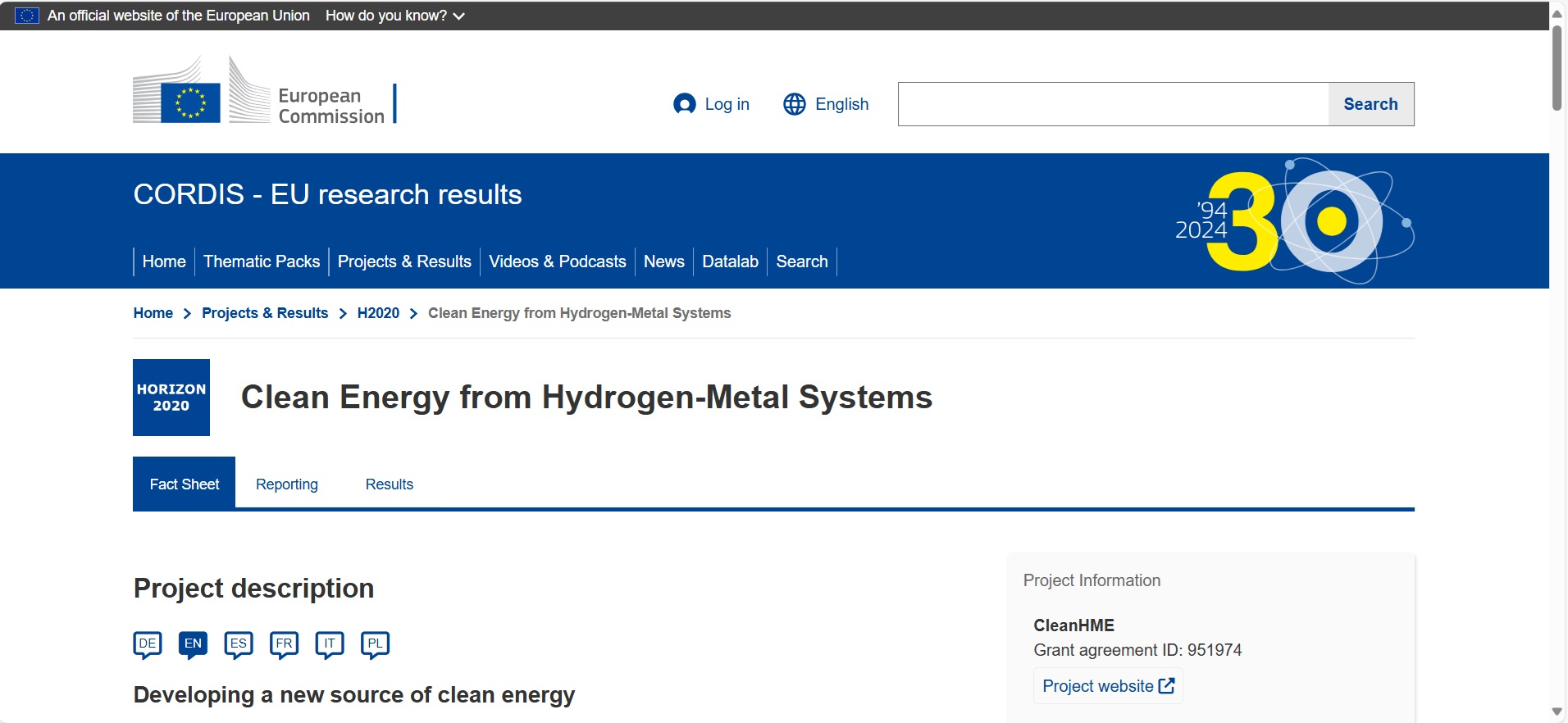 CleanHME project screenshot, see Project | Fact sheet | H2020 | CORDIS | European Commission
CleanHME project screenshot, see Project | Fact sheet | H2020 | CORDIS | European Commission
The LENR News website also talks about the recent Guardian debate on cold fusion. This started with a letter from Luca Garzotti pointing out the issues with hot fusion such as the need to breed tritium and withstand the neutron flux. I particularly liked the follow-up letter from Brian Josephson⁹ plus others such as Alan Smith, reminding the reader of cold fusion. In addition I liked the letters by Huw Price and the Arpa-E LENR researchers. The latter is also given on an ENG8 website where you can also read about a self-powering fusion reactor. Meanwhile Alan Smith is on the LENR forum, and is CEO of the International Society for Condensed Matter Nuclear Science (ISCMNS). He said this: “If I were to bet on which LENR companies would be the first to market, ENG8 would be in the top two”. The other LENR company he was thinking of is a Japanese company called CleanPlanet.
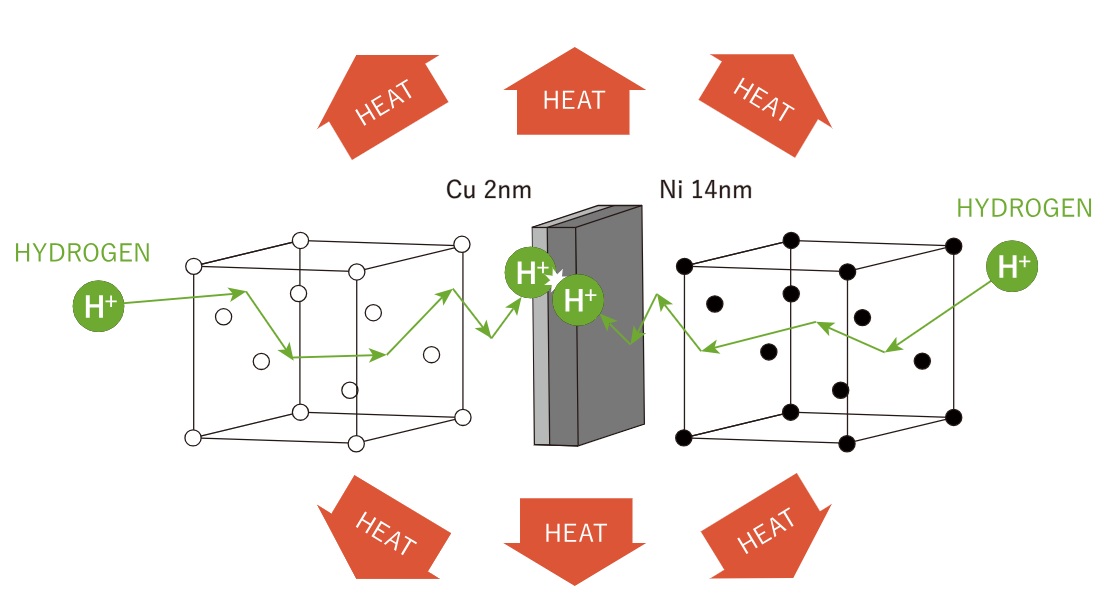 Screenshot from CleanPlanet
Screenshot from CleanPlanet
The ISCMNS has a journal, see JCMNS.org. It’s also associated with a bi-annual conference. The next one is the 26th International Conference on Condensed Matter Nuclear Science. That’s in Japan in May 2025, see iccf26.org. I hope it goes well.
The Wikipedia editors really do not like cold fusion
I should add that an alternative name for LENR is CANR, which stands for Chemically Assisted Nuclear Reactions. See LENR-CANR.org maintained by Jed Rothwell for a wealth of reference material. The Introduction is an easy-reading overview by Edmund Storms. Check out the Wikipedia cold fusion article and you can read that other names are Lattice Assisted Nuclear Reactions (LANR), Condensed Matter Nuclear Science (CMNS) or Lattice Enabled Nuclear Reactions (LENR again). The Wikipedia article also says “the new names avoid making bold implications, like implying that fusion is actually occurring”. Those Wikipedia editors really do not like cold fusion, perhaps I should have a word. There’s also LENRIA, and LENRGY where the Initiatives and Projects page tells us more about Edmund Storms’s background. There’s also the NASA lattice confinement fusion work I mentioned in the notes last time. Robert Bryant advises that the team presented at ICCF25 in Szcezcin, but doesn’t know if they’ll be at ICCF26 in Japan in May:
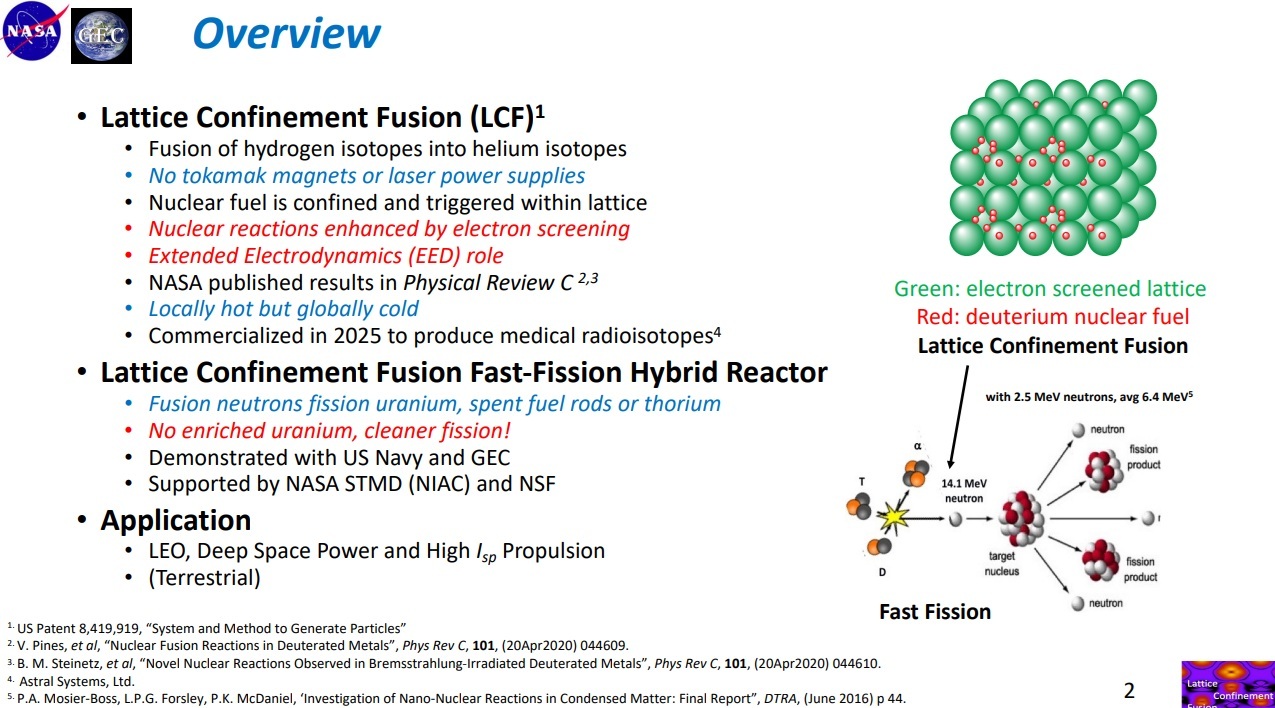 LCF image by NASA / Lawrence P Forsley, Dr Pam A Mosier-Boss, Dr Theresa L Benyo, and Dr Rodger W Dyson
LCF image by NASA / Lawrence P Forsley, Dr Pam A Mosier-Boss, Dr Theresa L Benyo, and Dr Rodger W Dyson
OK, that’s enough from me, because like I said, this is above my pay grade, so I’ve got some reading to do. All in all there’s some great stuff out there. Check out the LENR forum news. Have a look at the New Energy Times. Watch the ISCMNS cold fusion videos. There’s some serious work going on, and the world needs it. The story started 36 years ago, and hot fusion just hasn’t delivered. CERN are supposed to be the Centre European for Research Nuclear, but they aren’t working on thorium power, or anything else that holds out hope. Ditto for the US Department of Energy. We’ve been paying Big Science to deliver nothing. No, it’s worse than that. It’s less than nothing. All those billions of dollars of science funding aren’t just wasted. That science funding is more than wasted, because it’s used and abused for propaganda and censorship, to peddle “discoveries” that don’t stand up to scrutiny, and stifle the physics that would make a difference. So I will do what I can to help the LENR community. Because in my mind cold fusion is the Cinderella of nuclear physics, and she has some ugly sisters.
NEXT
1 The irony is that contemporary particle physics suffers from serious flaws. The biggest one in my view is that the electron is claimed to be a point particle, when the evidence points to it being a wave structure. As far as I can tell this started in the 1920s when the Copenhagen school adopted Yakov Frenkel’s point-particle electron to spite realists like de Broglie, Darwin, and Schrödinger. It was all downhill from there, with things like renormalization and messenger particles which do not fit with other aspects of physics.
2 John Theophilus Desaguliers worked for Newton as an experimentalist. See the article by Linda Hall: “Isaac Newton, who was president of the Society, seems to have taken a liking to young Desaguliers, who was forty years his junior, and arranged for Desaguliers to be elected Fellow of the Society in 1714, which was not customary for mere ‘mechanics’”. I’m a big fan of Newton. See Mr Newton’s Classroom.
3 At circa 2000 m/s it’s not that slow. A slow neutron might be travelling twice as fast as a modern rifle bullet, which rips through the air at maybe 1000 m/s. The US civil war Minié balls moved at less than 300 m/s. However at circa 500 grains, the Minié balls bullet mass was circa ten times the mass of a 223 Remington.
4 Many thanks to Alan Smith, Shane D, Orsova, Jed Rothwell, Robert Bryant, Jürg Wyttenback, David Fabrice, Cydonia, Curbina, Frogfall, PhysicsforDummies, and Zephir at the LENR forum.
5 The photon has an E=hf wave nature. It’s pure kinetic energy because when you remove energy from a wave, the wave is diminished, and when you remove all the energy, and the wave isn’t there any more. When part of a photon is absorbed by an electron in Compton scattering it’s akin to taking a slice off the photon and applying it to the electron in an asymmetrical fashion, so the electron moves. You could then repeat this, so that another particle moves. Do this in a lattice such that millions of particles move, and the result is what we call heat.
6 Again, if you think pions pop in and out of existence, spontaneously, like worms from mud, I’ve got a bridge you might like to buy. There are no messenger particles, period. So there are no gluons, there are no W bosons, there are no Z bosons, and there are no gravitons. By the way, there is no quantum entanglement either. It’s just Malus’s law with the light source in the middle.
7 The proton is similar but in a tighter trefoil configuration. The g-factor of 5.585 is clear evidence for this, and the trefoil is the next knot in the knot table after the trivial knot. Sir Michael Atiyah of TQFT fame knew about this, but the Standard Model people don’t. This is the real reason why you have never seen a free quark, and never ever will.
8 See The Higgs Fake by Alexander Unzicker. He makes it clear that the “discovery” of the Higgs boson was inferred from a mere bump on a graph. He also wrote about the Fermilab “discovery” of the top quark, which was “seen to decay” into a bottom quark and a W boson. Unzicker points out that we’ve never actually seen a bottom quark, or a W boson, so Fermilab inferred the existence of the top quark from particles that were themselves inferred. It’s similar for the “discovery” of the W and Z bosons, which were inferred from high-energy electrons. And these guys accused Fleischmann and Pons of scientific fraud? My irony meter is off the charts.
9 Brian Josephson is one of the good guys. See his 2004 article on covert censorship by the physics preprint archive. Search the arXiv on LENR, and there’s only 18 hits.
Sergei A. Tcvetkov. The Presumption of Pseudoscience. In Defense of Electrochemists Martin Fleischmann and Stanley Pons, and Cold Fusion, of Course! Proceedings of the 23rd International Conference on Condensed Matter Nuclear Science, Virtual Conference from Xiamen, China June 9–11, 2021, J. Condensed Matter Nucl. Sci., Volume 36, November 2022, JOURNAL OF CONDENSED MATTER NUCLEAR SCIENCE, ISSN 2227-3123, pp. 395-407. https://jcmns.scholasticahq.com/article/72612
Sergei: I will take a look. Many thanks.
I would love to hear what you think of this work.
Cold fusion made a believer out of me 35 yrs. ago. A high copper content brass portioning valve cold welded itself to the castiron engine block of my 1985 Olds Delta 88. It was a main junction in the block’s water jacket for the vehicle’s HVAC systems.
I had to retrofit an external aftermarket plastic valve that supposedly ran off of carburetor vaccume? It sucked.
LOL! Good stuff Greg. PS: I’ve got your email. Oh the joy if pottering around in the garage. I’d quite like to do up a classic car. However I never seem to have enough free time. PS: I’ve got your email. I will get back to you on it.
Sir Detective,
“no such thing as a cold or hot molecule” (paraphrased)
Indeed.
“Cold” and “hot” are words that probably ought not be used in quantum physics nomenclature (Good Nomenclature: A Matter of Life and Death);
These are two words that can be used when talking to laymen or in seriously non-technical discussions.
But we know “hot” water and “cold” water when we get into them don’t we?.
I took a surfboard to Alaska in 1968 and now they surf all over Alaska (it has more coastlines than the entire “lower 48” states put together).
Anyway, about a decade or so ago I was surfing at Malibu, California on a “cold” day in “cold water” (water with molecules/atoms at energy level odds with “hot water” molecules/atoms ;)).
The local surfers there were puzzled that I wasn’t wearing a wetsuit as they were (“how do you do it” one asked).
It reminds me of the weather people who say it is 72 degrees today but it “feels like” 68.
I always think “hey you guys lose that notion”, because not everyone “feels” temperature (hot/cold) the same.
But I digress.
Molecules/atoms of ocean water contain different amounts of absorbed photons that increase energy quantity level.
It is an impermanent, changing amount.
As the quantity of absorbed photons changes, the energy level in a water molecule/atom changes.
The “Second Law of Thermodynamics” indicates that higher energy levels in a molecue/atom will cause photons to be emitted by a molecule/atom to be absorbed in molecules/atoms nearby that contain a lower energy level than the emitter molecule/atom contains.
Don’t ask me how.
Anyway, “hot” and “cold” are not sufficiently technical terms, but note that using them improperly can get us into “hot water” eh? ;).